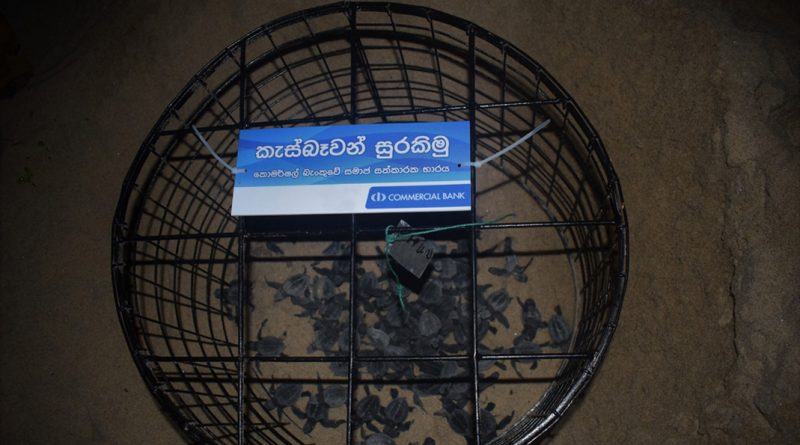ComBank’s turtle protection project sees over 8000 hatchlings released in 8 months
Thousands of turtle hatchlings have been safely released to their natural habitat under an initiative supported by the Commercial Bank of Ceylon to protect these endangered mariners and promote bio-diversity.
In the past eight months alone, 8,490hatchlings from 70protected turtle nests in Panama in theAmparaDistrict,were returned to the ocean through theBank-funded marine turtle conservation project of Wildlife and Ocean Resource Conservation (WORC) of Sri Lanka, a project Commercial Bank has supported since 2019.
The immediate objective of the project isprotecting the nests and eggs of sea turtles within the identified territory from predators such as pigs, foxes, mongoose, spotted iguana, and dogs.With Commercial Bank’s participation, WORC expanded its efforts to three kilometres of previously unprotected beach last year and to another three kilometres in 2021.
The initiative benefits four species of turtles including the Videlicet Green, Olive Ridley, Loggerhead, and Leatherback turtles that call this stretch of beach their home.The success of the collaborative conservationactivities last year inspired the Bank and WORC to extend the term of theMoU governing the project.
Commercial Bank’s support was instrumental in protecting seven turtle nests in September 2020, eight nests each in October, November, and December 2020, and 25, 29 and 25 nests respectively from January to March in 2021. Of these, 110 nests were of endangered turtlespecies: 89 nests of Olive Ridley, 14 nests of Green Turtle, and seven nests of Loggerhead.The protection of nests persisted despite interruptions to night patrols, owing to frequent leopard visits at night in the past few months, according to the nest protectors.
The ultimate aim of the project is to restore a degraded ecosystem and inspire a culture and community of environmental stewardship. Besides funding the project, Commercial Bank also supports WORC in its efforts to build partnerships with communities, raise education and awareness, and identify sustainable livelihoods and business opportunities associated with the project and kick-start associated activities. The Bank said it will engage actively in the project wherever possible.
Wildlife and Ocean Resource Conservation initiated the turtle conservation project in 2013 at the Panama beach under the observation and instruction of Professor K.B. Ranawana and MrVimukthi Veerathunga. The territory spans the 17km coastline from the Panama Lagoon to Okada Lagoon or the Kumana National Park entrance. With financial support from supportive organizations WORC fulfilled its conservation objectives which included identifying egg collectors, educating them about the importance of protecting turtles and converting them into nest protectors. Since 2013, the survival rate of hatchlings and eggs has increased, from 13,564 eggs and 12,265 hatchlings in 2013 to 17,500 eggs and 15,700 hatchlings in 2018.
The conservation initiatives of WORC in Panama are important because four of the seven species of sea turtles in the world come ashore to nest in Panama. Of these, the Leatherback has only been reported once after twenty years. While all seven species are included in the IUCN red list of threatened animals, the species of Kemp’s Ridley, Hawksbill, and Leatherback are considered critically endangered, and the Loggerhead, Green Turtle and Olive Ridley are listed as endangered.
Wildlife and Ocean Resource Conservation is a not-for-profit organisation focused on conservation and ecosystem restoration in Sri Lanka. It supports community-based sea turtle conservation in Panama and Pottuvil, mangrove forest conservation and restoration in Koggala, and coral reef conservation and restoration in Rumassala. WORC offers travel experiences in all of these areas and all income from ecotourism is used to fund ongoing conservation and restoration work.
Commercial Bank of Ceylon also collaborated with WORC on a mangrove restoration project, the first phase of which was completed recently and the second phaseset in motion.Under the first phase of the ‘Koggala Mangrove Restoration and Conservation Project,’ the Bank funded the planting of 2,000 mangrove plants, 750 mangrove associates, and 500 terrestrial plants on ‘Kath Duwa, a little island in the Koggala Lake. Phase two entails the planting of another 3,750 mangrove saplings to form a protective boundary around the island.
Views: 34


